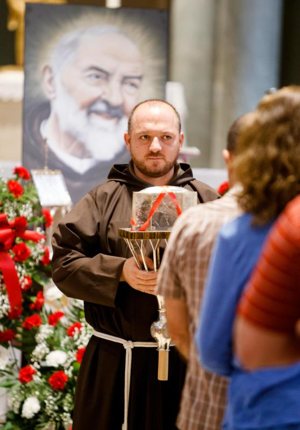
Virginia Fierro met St. Padre Pio back when she was 14 and still living in Italy, and on Sept. 21, she had the chance to venerate his heart in the Boston Archdiocese.
Sitting in a pew in St. Leonard’s Church in Boston’s North End, Fierro said she lived in Italy until moving to the United States in 1956, and it was there that she met the saint.
“We talked to him. We saw him just like he is now, with the hands like this,” she said, motioning toward a nearby statue of St. Padre Pio with his arms outstretched.
She said a large number of people showed up to see him, but “he talked to everybody.”
“It was beautiful,” Fierro told The Pilot, the Boston archdiocesan newspaper.
The heart of St. Padre Pio, the only major relic of the saint to leave Italy, was brought to the Boston metro area by the Capuchin friars who run the Shrine of St. Padre Pio in the saint’s hometown of San Giovanni Rotondo in southern Italy.
Padre Pio, who was born in 1887 and died in 1968, was canonized in 2002. The Capuchin friar was popular as a miracle worker and known particularly for the long hours he would spend hearing confessions.
From Sept. 21 to Sept. 23, the saint’s relic moved around the Archdiocese of Boston, stopping at several different parishes. The first day it was at Immaculate Conception in Lowell, and later that day it was at St. Leonard’s Church. The next day it was at the archdiocesan pastoral center in Braintree and later at the Cathedral of the Holy Cross in Boston, where it remained all day Sept. 23.
Dalila Patrizzi was the first person to venerate the relic at Immaculate Conception, and also was the first person to publicly venerate it during its time in the Boston area.
St. Padre Pio is “such a special saint, I mean all the saints are special, but this one endured so much, and he stayed, his loyalty, his endurance, his temperance everything, it’s very encouraging,” she said.
To beat the crowd, she parked her car in the parking lot in the wee hours of the morning and stayed there with her young son, Gabriel, until public veneration began at 9 a.m.
Patrizzi and her son stayed up all night in the parking lot, watching movies and praying to stay awake.
“I think it’s been a very special night,” said Gabriel.
Amii Stewart, an American disco singer best known for her 1979 cover of “Knock on Wood,” attended the night Mass at St. Leonard later that day. She traveled from Italy, where she currently resides, to sing at the Cathedral of the Holy Cross in honor of St. Padre Pio.
Stewart sang the song “Con Te Partiro” (“Time to Say Goodbye”) at the 2009 reburial of St. Padre Pio’s remains. In March 2008 the saint’s body was exhumed to allow procedures to guarantee prolonged preservation of his body.
The singer told The Pilot that she didn’t learn about him until she moved to Italy.
“I also learned about the controversy around Padre Pio where a lot of his fellow priests and monks didn’t believe him, so it took him a very, very long time to be looked upon as being touched by God. So, even he himself, he not only had the stigmata, but he also had to deal with people who didn’t believe that he was real, that he had been touched by God,” she said.
From 1918 to the very end of his life, Padre Pio bore the stigmata, wounds similar to those inflicted on Christ when he was crucified.
“I think all of us can relate to that in our lives, being looked upon either as having lied for something we didn’t do or being blamed for something we didn’t do or not being looked upon as being who we really are, and I can only image what he must have suffered and how he must have suffered,” Stewart continued.
She said it’s “it’s very special to me” to be able to be able to called upon to help honor St. Padre Pio, noting that she has been called to sing in honor of the saint “many, many times.”
Stewart said someone told her that she’s been called so many times because St. Padre Pio wants her to be there.
“And so then I start to question why would he want me to be there? What have I done that’s so great, you know, that he would want me?” she wondered.
“So, he must see something in me that I can’t see in myself, or I haven’t discovered my whole reason for being here, on this earth, obviously, there must be something else I need to do, and I’m sure he’ll reveal that to me,” Stewart said.
At the pastoral center, Mary Onorato was waiting in line to venerate the relic and pray for her daughter.
“Padre Pio had the stigmata, and my daughter has rheumatoid arthritis and she can’t use her hands, so I’m here to pray for a miracle for her,” she said, adding that her daughter shares a May 25 birthday with St. Padre Pio.
“In the community of saints, Padre Pio can now intercede for us,” Onorato said.
Labbe is a reporter at The Pilot, newspaper of the Archdiocese of Boston.



